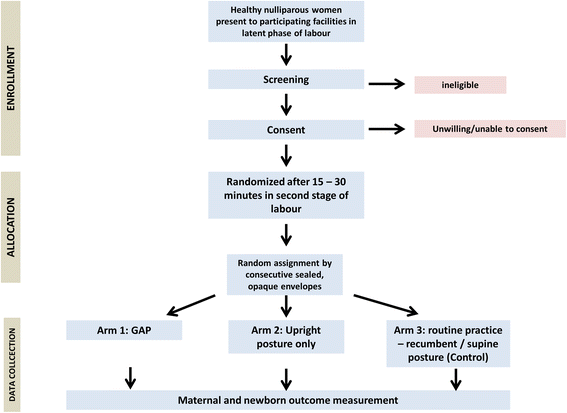A multicentre randomized controlled trial of gentle assisted pushing in the upright posture (GAP) or upright posture alone compared with routine practice to reduce prolonged second stage of labour (the Gentle Assisted Pushing study): study protocol
- PMID: 26669766
- PMCID: PMC4681100
- DOI: 10.1186/s12978-015-0105-9
A multicentre randomized controlled trial of gentle assisted pushing in the upright posture (GAP) or upright posture alone compared with routine practice to reduce prolonged second stage of labour (the Gentle Assisted Pushing study): study protocol
Abstract
Background: Fundal pressure (pushing on the upper part of the uterus in the direction of the birth canal) is often performed in routine practice, however the benefit and indications for its use are unclear and vigorous pressure is potentially harmful. There is some evidence that it may be applied routinely or to expedite delivery in some situations (e.g. fetal distress or maternal exhaustion), particularly in settings where other methods of achieving delivery (forceps, vacuum) are not available. Gentle assisted pushing (GAP) is an innovative method of applying gentle but steady pressure to the uterine fundus with the woman in an upright posture. This trial aims to evaluate the use of GAP in an upright posture, or upright posture alone, on reducing the mean time of delivery and the associated maternal and neonatal complications in women not having delivered following 15-30 min in the second stage of labour.
Methods/design: We will conduct a multicentre, randomized, unblinded, controlled trial with three parallel arms (1:1:1). 1,145 women will be randomized at three hospitals in South Africa. Women will be eligible for inclusion if they are ≥18 years old, nulliparous, gestational age ≥ 35 weeks, have a singleton pregnancy in cephalic presentation and vaginal delivery anticipated. Women with chronic medical conditions or obstetric complications are not eligible. If eligible women are undelivered following 15-30 min in the second stage of labour, they will be randomly assigned to: 1) GAP in the upright posture, 2) upright posture only and 3) routine practice (recumbent/supine posture). The primary outcome is the mean time from randomization to complete delivery. Secondary outcomes include operative delivery, adverse neonatal outcomes, maternal adverse events and discomfort.
Discussion: This trial will establish whether upright posture and/or a controlled method of applying fundal pressure (GAP) can improve labour outcomes for women and their babies. If fundal pressure is found to have a measurable beneficial effect, this gentle approach can be promoted as a replacement for the uncontrolled methods currently in use. If it is not found to be useful, fundal pressure can be discouraged.
References
-
- National Collaborating Centre for Women's and Children's Health (UK) Intrapartum care: care of healthy women and their babies during childbirth. London: RCOG Press; 2007. - PubMed
-
- Verheijen EC, Raven JH, Hofmeyr GJ. Fundal pressure during the second stage of labour (Review). Cochrane Database Syst Rev. 2009 (4). Art. No.: CD006067. http://www.ncbi.nlm.nih.gov/pubmed/19821352 - PubMed
Publication types
MeSH terms
Grants and funding
LinkOut - more resources
Full Text Sources
Other Literature Sources
Medical
Miscellaneous


